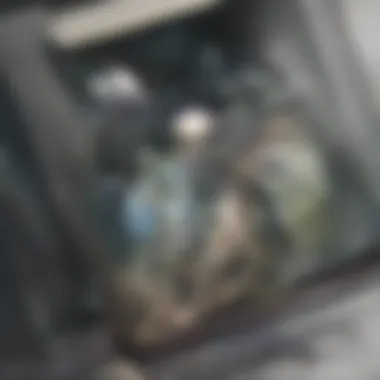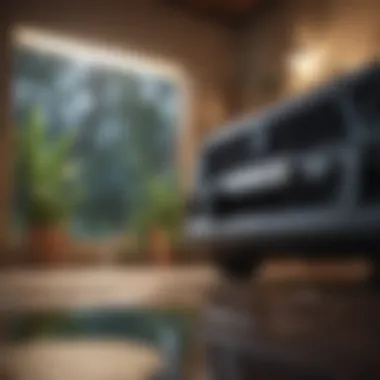DIY TV Screen Cleaner: A Comprehensive Guide


Intro
In today's world, screens are ubiquitous. Given the rise of streaming services, gaming, and even work-from-home environments, television screens face an array of smudges and fingerprints. Keeping these surfaces clean is not merely about aesthetics; it’s about enhancing the viewing experience and prolonging the life of the device. This guide will reveal how easily and effectively one can whip up a DIY TV screen cleaner using accessible ingredients.
Understanding what contributes to a clean screen will help both homeowners and tech enthusiasts choose the right approach in maintaining electronic devices. By adopting safe and efficient cleaning methods, readers will not only clean their screens but also contribute to a more sustainable future by using environmentally friendly products.
The discussion will include essential ingredients, the best practices for cleaning, and safety precautions to take during the process. With the right knowledge, one can ensure that their television screens remain crystal clear without harming the devices. Let’s delve into the specifics.
Preface to TV Screen Maintenance
Television screens are central to our daily entertainment and information consumption. Maintaining these screens is crucial for preserving their functionality and visual quality. Routine maintenance not only enhances the viewing experience but also extends the lifespan of the device.
Keeping a screen clean prevents dust, fingerprints, and other debris from marring the display. Additionally, a clean screen ensures that the brightness and contrast settings function optimally, allowing for a more immersive experience.
Proper maintenance involves understanding how to clean screens based on their type and the materials used in the cleaning process. This knowledge will help maintain the screen's structural integrity and performance over time, ultimately saving money on repairs or replacements.
The Importance of Cleaning
Cleaning television screens regularly is essential. Over time, grime accumulates. Dust particles, smudges from fingers, and even cooking residues may cling to the surface. Not only does this degradation affect picture quality, but it can also cause more severe issues, such as permanent damage to the display.
Using a dedicated cleaning solution is vital. Commercial cleaners can cause hazing and damage, while homemade options, if made correctly, prove to be effective and gentle on screens. Regular cleaning can lead to a significant enhancement in clarity, thus improving overall viewing pleasure.
Common Issues with Dirty Screens
Dirty screens lead to various visual impairments. Often, users notice a dull appearance or blurriness in images. Such problems can stem from simple dust accumulation. However, buildup can also create static electricity, attracting even more dust.
Moreover, improper cleaning methods may scratch the screen surface. Using abrasive materials or incorrect solutions can lead to irreversible damage. Preventative measures include using the right cleaning solutions and techniques to avoid common mistakes.
In summary, understanding TV screen maintenance is not merely a preference but a necessity. It preserves the functionality and aesthetic appeal of the device. An informed approach to cleanliness will significantly enhance the quality of any viewing experience.
Understanding Different Screen Types
Cleaning a TV screen is not a one-size-fits-all approach. Different screen technologies have distinct characteristics that affect how they should be maintained. Understanding these different types is pivotal to ensuring that your cleaning methods do not harm the screen or reduce its lifespan. More importantly, recognition of these technologies leads to better clarity and performance of your visual display, enhancing your viewing experience significantly.
Screens
LCD, or Liquid Crystal Display, screens are widely used in TVs. These screens rely on a backlight to produce images. They are relatively resistant to scratches and can withstand a degree of moisture.
When cleaning an LCD screen, it is wise to avoid using excessive pressure as this can damage the liquid crystals inside. A solution diluted from water and a small amount of vinegar is effective. Avoid paper towels; instead, opt for a microfiber cloth. The right technique will keep the screen clear and vibrant.
OLED Screens
OLED stands for Organic Light Emitting Diodes. This technology allows for thinner screens, with the added benefit of deeper blacks and more vivid colors. However, OLED screens are more sensitive than LCDs, making them more vulnerable to damage from harsh materials or chemicals.
For cleaning, a dry microfiber cloth works best. If needed, light moisture can be added. Solutions containing alcohol or ammonia must be avoided at all costs. A gentle wipe will ensure that the screen remains in peak condition and the color fidelity is not compromised.
Plasma Screens
Plasma screens are known for their exceptional color depth and blacks. They use gas to produce images, which makes them more sensitive to heat and light than other types. Dust and smudges can be more evident on these screens, necessitating regular cleaning.
Cleaning plasma screens requires similar caution; a damp microfiber cloth is preferable. It is important not to use any sprays directly on the screen, as they could seep into the edges and damage the components. A careful, gentle touch will help maintain their stunning visuals while extending their life.
DIY TV Screen Cleaner Ingredients


Understanding the right ingredients for a DIY TV screen cleaner is essential. Not only does it influence the effectiveness of cleaning but also impacts the longevity of your screen.
Choosing the right cleaning solution can safeguard your television from damage. Many household cleaners can contain harsh chemicals. These are unsuitable for delicate screens like LCD or OLED. Thus, using non-toxic and safe ingredients is imperative to maintain the quality of your device.
Common Household Items
Many people may not realize that effective cleaning can often be done with items readily available at home. Here is a list of common household items suitable for creating a DIY TV screen cleaner:
- Distilled Water: Purified of minerals, this water does not leave streaks or residues. It dissolves dirt effectively without harming the screen.
- White Vinegar: A weak acid, white vinegar can help break down grime and dust. It is safe for most screens when diluted.
- Isopropyl Alcohol (70% or less): This alcohol can effectively remove fingerprints and smudges. Use it carefully, as high concentrations can damage sensitive screens.
- Microfiber Cloths: While not an ingredient per se, using a microfiber cloth is crucial for applying solutions safely. They do not scratch the surface.
Utilizing these household items minimizes costs while ensuring safety. They provide excellent alternatives to commercial cleaning products.
Commercial Products vs. Homemade Solutions
When it comes to cleaning television screens, the market offers various commercial products designed specifically for this. However, these products can be frequently pricey. On the contrary, homemade solutions offer several benefits:
- Cost-Effectiveness: Creating your own cleaner will generally save you money compared to purchasing ready-made options.
- Customization: You can easily customize the solution according to your preferences and needs. For example, adjusting the concentration of vinegar or alcohol to suit your screen type.
- Safety: You control the ingredients, thus minimizing exposure to harsh chemicals found in many commercial cleaners. This is important for households with children or pets.
- Environmental Impact: Homemade solutions often comprise eco-friendly ingredients, supporting your commitment to sustainability.
Despite the benefits of homemade cleaners, it’s essential to research and ensure that any mixture does not contain harmful components. In many cases, a thoughtful blend of the common items mentioned above will suffice for effective cleaning.
"Crafting a suitable cleaning solution at home not only enhances screen clarity but also contributes to the sustainability of your living space."
By delving into these ingredients, you can better understand how to care for your TV screen and enjoy its visual quality for years to come.
Step-by-Step Guide to Making Your Cleaner
Creating your own TV screen cleaner is not just about saving money. It is also about understanding what goes onto your screen and how to clean it effectively without causing damage. This section provides clear steps to create a cleaner that is both safe and effective. Following this guide will ensure optimal clarity for your screen and help maintain its longevity, which is beneficial for those invested in their viewing experience.
Choosing the Right Container
When preparing your DIY screen cleaner, the choice of container plays a significant role. A clean, non-abrasive bottle is essential to avoid contaminants.
- Material Considerations: Glass or high-grade plastic bottles work well. Avoid using bottles made of cheap plastic that may leach harmful chemicals.
- Spray vs. Pump Dispenser: A spray bottle is preferred because it allows for controlled application. Using a pump bottle may result in too much cleaner being dispensed.
- Size: Opt for a size that fits your needs. If you plan to make larger batches, ensure the container is appropriately rated to hold the solution.
By selecting the right container, you protect the integrity of your cleaner and simplify the application process.
Mixing Ratios
The effectiveness of your cleaner largely depends on getting the mixtures right. Here are key points to consider when determining mixing ratios:
- Water to Alcohol Ratio: Using distilled water is best to prevent mineral spots. A common ratio is 50% distilled water and 50% isopropyl alcohol.
- Targeted Solution: If your screen is particularly dirty, you may lean toward a stronger solution, adjusting to 70% alcohol and 30% water. However, ensure you test a small area first to guarantee it does not harm the screen.
- Additives: If desired, a few drops of gentle dish soap can be added for extra cleaning power. Mixing these should be done with care to avoid excess foam.
Get these ratios right, and you enhance the cleaning ability of your solution without damaging the screen.
Storage and Shelf Life
Once your cleaner is mixed, you must think about how to store it properly to maintain its effectiveness. This aspect is important for convenience and safety.
- Labeling: Always label your container with the contents and the date of creation. This helps track its age and use.
- Ideal Conditions: Store the cleaner in a cool, dry place away from direct sunlight. High temperatures can degrade the effectiveness of the alcohol.
- Shelf Life: Typically, a DIY screen cleaner can last anywhere from 1-3 months. Regularly check it for any changes in smell or consistency.
Proper storage ensures the cleaner remains effective and safe for use over time.
Effective Cleaning Techniques
Effective cleaning techniques are vital for ensuring the longevity and clarity of your TV screen. Understanding how to clean a delicate surface properly can prevent damage and enhance your viewing experience. The techniques that will be discussed here are simple and practical. By applying the right method, you can effectively remove dirt, dust, and smudges without risking harm to your screen's display.


Direct Application Method
Using the direct application method is straightforward. This technique involves applying the cleaning solution directly to the screen. However, caution is necessary. You should avoid soaking the screen, as excess liquid can cause harm to internal components.
When using this method, follow these steps:
- Prepare your cleaning solution, ensuring it is safe for your specific screen type.
- Lightly spray the solution onto a soft cloth, not directly on the screen.
- Gently wipe the screen in a circular motion, applying minimal pressure. This helps to lift the dirt without damaging the screen.
This method is effective for quick clean-ups but remember to use it sparingly to avoid moisture build-up.
Cloth Method
The cloth method is another excellent option for cleaning your TV screen. It emphasizes the use of appropriate materials. Using a microfiber cloth is recommended as it can trap dust and oils effectively without scratching the surface.
Here is how you can use this technique:
- Ensure the TV is turned off and cool to the touch.
- Dampen your cloth lightly with a cleaning solution. Avoid drenching it.
- Wipe the screen using horizontal or vertical strokes. This method helps to cover the entire surface evenly.
This technique is highly effective for regular maintenance and removes fingerprints and other markings efficiently. Regular use can keep your screen in good condition.
Compressed Air Use
Compressed air can be a surprising but effective tool in your cleaning arsenal. This method is especially useful for removing dust from hard-to-reach areas, like the edges of the screen or vents.
To use compressed air effectively:
- Hold the can upright to prevent liquid from escaping.
- Spray the compressed air at a safe distance, around six to twelve inches from the screen to avoid damage.
- Move the nozzle around to dislodge dust without contacting the screen directly.
This technique is great as a supplementary cleaning method. It can be used in conjunction with cloth techniques to maintain a spotless TV screen.
Key Takeaway: Utilizing effective cleaning techniques not only ensures a clear display but also prolongs the life of your television. Choose the method that fits your situation and follow the guidelines for optimal results.
Safety Precautions
When it comes to cleaning your TV screen, safety precautions are paramount. Not only do they protect your investment in your television, but they also ensure your own well-being during the cleaning process. Improper cleaning techniques or the use of inappropriate materials can lead to lasting damage to the screen or pose health risks.
Choosing Non-Abrasive Materials
Selecting non-abrasive materials is essential in avoiding scratches or scuffs on the screen. Many common household items might seem harmless but can be detrimental to delicate screen surfaces.
- Soft Cloths: Use microfiber cloths specifically designed for electronics. These cloths are gentle and do not leave lint or scratches. Avoid using paper towels or rough fabrics, as they can cause micro-scratches.
- Gentle Cleaning Solutions: When making a cleaner, ensure that the sprays or wipes do not contain any harsh ingredients like ammonia, which can damage certain types of screens. A mixture of distilled water and simple vinegar can be effective without being harsh.
These non-abrasive materials not only guarantee a clear screen but also enhance the longevity of the device while ensuring a safe cleaning process.
Avoiding Harmful Chemicals
Choosing the right cleaning solutions is crucial for preserving the integrity of your television. Many commercial cleaners contain harmful chemicals that can degrade screen quality over time.
- Read Ingredients Carefully: Always check the labels of commercial cleaning products. Look out for ingredients like alcohol, ammonia, and heavy fragrances. These substances can damage your screen and lead to discoloration.
- Homemade Alternatives: Instead of resorting to potentially harmful chemicals, create your own solutions. A mix of water and isopropyl alcohol in a ratio of 1:1 can be effective for certain screens, but always double-check with the manufacturer’s guidelines.
"Using the wrong chemicals not only endangers the screen's condition but can pose health risks, particularly in poorly ventilated spaces."
Being mindful of the products you choose will help to maintain a safe environment for both the television and yourself. Taking these precautions can lead to a more effective cleaning experience, ensuring you enjoy your viewing without interruption.
Routine Screen Maintenance


Routine maintenance of a television screen is vital in preserving its functionality and aesthetic appeal. Regular cleaning helps to eliminate dust, fingerprints, and smudges that can obscure picture quality. A clean screen not only enhances viewing pleasure but also extends the life of the display.
Frequency of Cleaning
The frequency of cleaning your TV screen is not uniform and can depend on various factors. Generally, it is advisable to clean your screen at least once a month. However, if your household has pets or small children, you may need to clean more often due to increased likelihood of smudges and debris.
Here are some pointers for determining the frequency of cleaning:
- Household Environment: Homes with more dust, pets, or frequent usage may require weekly cleanings.
- Viewing Habits: High usage, such as binge-watching series, also means more chances for fingerprints on the screen.
- Type of TV Screen: LCD and OLED screens may show fingerprints more readily than older models, prompting more frequent attention.
Preventive Measures
Implementing preventive measures can significantly reduce the need for frequent cleanings. Here are some strategies:
- Use a Screen Cover: A suitable cover can protect the screen from dust and scratches when not in use.
- Maintain Distance from Potential Dirt: Position the TV away from high-traffic areas where dust and spills are more likely.
- Regular Dusting: Utilize a microfiber cloth for gentle dusting around the area, which can minimize particulate matter settling on the screen.
- Control Humidity: Excessive moisture can lead to streaks and potential damage. Keep the living area well-ventilated to avoid this problem.
"Regular maintenance not only keeps your screen clean but also safeguards your investment in technology."
Adopting these practices can help ensure that your television serves you well for years to come. In the next sections, further insights into effective cleaning methods and safety precautions will provide a rounded understanding of how to care for your screen.
Environmental Considerations
Cleaning TVs is often overlooked in discussions about environment-friendly practices. Yet, the methods and materials we choose to maintain our screens can have significant impacts. This section explores eco-friendly cleaning solutions and strategies to reduce electronic waste.
Eco-Friendly Cleaning Solutions
Using environmentally sound cleaning solutions is vital for maintaining not just your screen, but also the planet. Standard cleaners may contain harsh chemicals that can be detrimental to the environment.
Here are some common eco-friendly ingredients:
- Distilled Water: A safe and effective base that does not contain minerals that can leave streaks.
- Vinegar: A natural disinfectant that can help remove smudges and can be diluted with distilled water.
- Olive Oil: Useful for a polished finish, but should be used sparingly to avoid residue.
By employing these simple ingredients, you ensure that your cleaning methods contribute to a healthier habitat. Furthermore, they often outperform commercial cleaners that make dubious green claims.
Reducing Electronic Waste
Televisions, like many electronics, have a limited lifespan. Addressing cleaning and maintenance can extend the life of these devices, thereby reducing waste.
Here are some considerations for minimizing electronic waste related to TVs:
- Regular Maintenance: Keeping screens clean helps them function better.
- Upcycling Options: Consider donating or repurposing older units instead of discarding them.
- Recycling Programs: Many manufacturers offer take-back programs for old electronics.
"The best way to reduce electronic waste is not to generate it in the first place. Take care of your devices to make them last."
By being mindful of our cleaning habits and focusing on sustainability, we not only care for our screens but also contribute positively to the environment.
The End: The Importance of Care
Proper care for television screens is crucial for ensuring their clarity and longevity. By regularly maintaining the screen, viewers can enjoy a better visual experience, prolong the life of their investment, and maintain the aesthetic appeal of their living spaces.
Final Thoughts on Screen Care
Taking good care of your TV screen enhances not only your viewing pleasure but also the device’s functionality. Dust and smudges can interfere with picture quality, making it essential to keep the screen clean. Furthermore, some screens are more susceptible to scratches and damage, which can result in costly repairs or replacements. Understand the specific needs of your television type, whether it is LCD, OLED, or plasma. Regular cleaning with the appropriate materials will help prevent damage and maintain the vibrancy of the display.
Remember, a clean screen can improve brightness and color accuracy, enriching your overall entertainment experience.
Encouragement for Regular Maintenance
Establishing a routine for screen care is a simple yet effective way to prevent buildup and damage. Aim to clean your TV screen at least once a month. For high-traffic areas, such as homes with children or pets, consider cleaning it weekly. In addition, adopting preventative measures such as placing screens away from direct sunlight and using microfiber cloths can help reduce the need for deep cleaning.
In sum, regular maintenance not only preserves the quality of your TV but also ensures that your viewing experience remains enjoyable. Keeping the screen free of dirt and grime can save you from potential costs linked to repairs and replacements. By being proactive, you can take significant strides in ensuring the longevity of your investment while also enjoying optimal performance.















